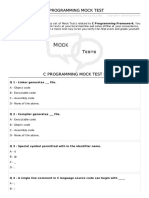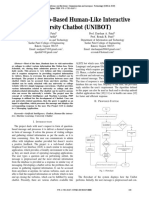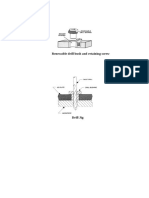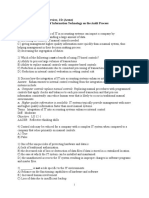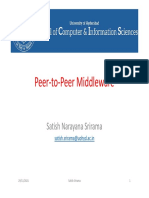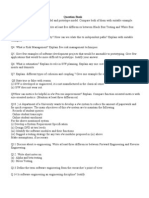PySpark Interview Questions
freedium.cfd/https://medium.com/@dheenmech007/pyspark-interview-questions-22d833bebdbb
androidstudio · August 16, 2024 (Updated: September 7, 2024) · Free: No
60+ PySpark Coding Questions Every Data Engineer Should Know
In today's data-driven world, Apache Spark is a key tool for big data processing. Among
its many libraries, PySpark, the Python API for Spark, stands out as an essential skill
for data engineers and scientists alike. Whether you're preparing for a job interview or
looking to deepen your understanding, this comprehensive guide will walk you through
the most common PySpark Interview Questions.
I'll also provide practical code examples, FAQs, and real-world applications to ensure
you're ready to impress the interviewer. And, if you're looking to further sharpen your
skills, checkout the recommended some top-rated courses available online.
PySpark Interview Questions and Answers:
Basic PySpark Interview Questions
These are the 10 Basic PySpark Interview Questions which we can probably encounter in
our early data engineer career. If you are a data engineer save this PySpark Interview
Questions for 3 years experience level and beyond.
1) What is PySpark?
Answer: PySpark is the Python API for Apache Spark, an open-source, distributed
computing framework. It allows you to work with RDDs (Resilient Distributed Datasets)
and DataFrames in Python while leveraging Spark's capabilities for big data processing.
Code Example:
from pyspark.sql import SparkSession
spark = SparkSession.builder.appName("PySparkExample").getOrCreate()
df = spark.read.csv("path/to/data.csv", header=True, inferSchema=True)
df.show()
2) What are the advantages of using PySpark over traditional Hadoop MapReduce?
Answer: PySpark offers several advantages:
1/17
� Speed: PySpark processes data faster than Hadoop MapReduce due to its in-
memory computation capabilities.
Ease of Use: PySpark provides a higher-level API with support for SQL,
DataFrames, and Machine Learning, making it more user-friendly.
Fault Tolerance: PySpark's RDDs are fault-tolerant and can recover data
automatically in case of failure.
Code Example:
rdd = spark.sparkContext.parallelize([1, 2, 3, 4, 5])
rdd.map(lambda x: x * 2).collect()
3) Explain the role of SparkContext in PySpark.
Answer: SparkContext is the entry point for accessing Spark functionalities. It represents
the connection to a Spark cluster and is responsible for initializing the Spark application.
Code Example:
from pyspark import SparkContext
sc = SparkContext("local", "First App")
rdd = sc.parallelize([1, 2, 3, 4])
print(rdd.collect())
4) What are RDDs in PySpark?
Answer: RDDs (Resilient Distributed Datasets) are the fundamental data structures in
PySpark. They represent an immutable, distributed collection of objects that can be
processed in parallel.
Code Example:
rdd = sc.textFile("path/to/textfile.txt")
word_counts = rdd.flatMap(lambda line: line.split(" ")).map(lambda word: (word,
1)).reduceByKey(lambda a, b: a + b)
word_counts.collect()
5) What are DataFrames in PySpark, and how do they differ from RDDs?
Answer: DataFrames are distributed collections of data organized into named columns,
similar to tables in a relational database. They provide a higher-level abstraction than
RDDs, offering optimizations and a richer API for working with structured data.
Code Example:
df = spark.read.csv("path/to/data.csv", header=True, inferSchema=True)
df.filter(df['age'] > 30).show()
6) How can you create a DataFrame in PySpark?
2/17
�Answer: You can create a DataFrame in PySpark by loading data from a variety of
sources such as CSV, JSON, or by converting an RDD to a DataFrame.
Code Example:
data = [("James", 34), ("Anna", 29)]
df = spark.createDataFrame(data, ["Name", "Age"])
df.show()
7) Explain the concept of lazy evaluation in PySpark.
Answer: Lazy evaluation means that PySpark doesn't execute transformations
immediately. Instead, it builds a logical execution plan, which is only triggered when an
action (like count(), collect(), save()) is performed.
Code Example:
rdd = sc.textFile("path/to/textfile.txt")
words = rdd.flatMap(lambda line: line.split(" "))
words.persist() # Caching data for subsequent actions
print(words.count()) # Action triggers execution
8) What is a SparkSession, and how does it differ from SparkContext?
Answer: SparkSession is the new entry point for DataFrame and SQL functionality in
PySpark, introduced in Spark 2.0. It internally manages SparkContext and other session-
related configurations. SparkContext is still available, but SparkSession simplifies the
API.
Code Example:
spark = SparkSession.builder.appName("ExampleApp").getOrCreate()
sc = spark.sparkContext # Accessing SparkContext from SparkSession
9) Describe the use of the withColumnRenamed() function in PySpark.
Answer: withColumnRenamed() is used to rename an existing column in a DataFrame.
Code Example:
df = df.withColumnRenamed("oldName", "newName")
df.show()
10) How do you handle missing data in PySpark?
Answer: PySpark provides several methods to handle missing data, including dropna() to
remove rows with null values, and fillna() to replace nulls with specified values.
Code Example:
3/17
� df.dropna().show() # Drops rows with any null values
df.fillna({'age': 30, 'name': 'Unknown'}).show() # Fills nulls with specified
values
Intermediate PySpark Interview Questions
As the years pass, an intermediate or senior level data engineer might have stumped by
these 10 intermediate pyspark interview questions. These 10 PySpark Interview
Questions for data engineer will equip you well for your upcoming pyspark interview.
11) Explain the use of the filter() transformation in PySpark.
Answer: The filter() transformation is used to filter rows in an RDD or DataFrame that
satisfy a given condition.
Code Example:
df.filter(df['age'] > 30).show()
12) How can you join two DataFrames in PySpark?
Answer: PySpark provides several types of joins, including inner, outer, left, and right
joins.
Code Example:
df1 = spark.createDataFrame([("John", 25), ("Anna", 30)], ["Name", "Age"])
df2 = spark.createDataFrame([("John", "New York"), ("Anna", "California")],
["Name", "State"])
df_joined = df1.join(df2, on="Name", how="inner")
df_joined.show()
13) What is the groupBy() function in PySpark, and how do you use it?
Answer: The groupBy() function is used to group DataFrame rows based on a specified
column and perform aggregation operations.
Code Example:
df.groupBy("age").count().show()
14) How can you write a DataFrame to a CSV file in PySpark?
Answer: You can use the write.csv() function to write a DataFrame to a CSV file.
Code Example:
df.write.csv("output/path", header=True)
15) Explain the use of UDFs (User Defined Functions) in PySpark.
4/17
�Answer: UDFs allow you to define custom functions in Python and apply them to
DataFrame columns.
Code Example:
from pyspark.sql.functions import udf
from pyspark.sql.types import StringType
def convert_case(name):
return name.upper()
convert_case_udf = udf(lambda z: convert_case(z), StringType())
df = df.withColumn("upper_name", convert_case_udf(df['name']))
df.show()
16) What are broadcast variables in PySpark?
Answer: Broadcast variables allow you to cache a read-only variable on each machine
rather than shipping a copy of it with tasks, which is useful when working with large
datasets.
Code Example:
states = {"NY": "New York", "CA": "California", "TX": "Texas"}
broadcast_states = sc.broadcast(states)
rdd = sc.parallelize([("John", "NY"), ("Anna", "CA")])
result = rdd.map(lambda x: (x[0], broadcast_states.value[x[1]])).collect()
print(result)
17) How do you perform a pivot operation in PySpark?
Answer: You can use the pivot() function in combination with groupBy() to perform a pivot
operation.
Code Example:
df.groupBy("name").pivot("age").count().show()
18) What is the purpose of the repartition() and coalesce() functions in PySpark?
Answer: Both functions are used to change the number of partitions in an RDD or
DataFrame. repartition() can increase or decrease the number of partitions, while
coalesce() only reduces them.
Code Example:
df_repartitioned = df.repartition(4)
df_coalesced = df.coalesce(2)
19) Explain the concept of DataFrame caching in PySpark.
5/17
�Answer: Caching is used to store the results of expensive operations in memory, allowing
faster retrieval for subsequent actions.
Code Example:
df.cache()
df.count() # Triggers the caching
20) What are accumulators in PySpark?
Answer: Accumulators are variables that are only "added" to through an associative and
commutative operation and can be used to implement counters or sums.
Code Example:
accumulator = sc.accumulator(0)
def count_elements(x):
global accumulator
accumulator += 1
return x
rdd = sc.parallelize([1, 2, 3, 4, 5])
rdd.foreach(count_elements)
print(accumulator.value)
PySpark Interview Questions and Answers for experienced
Below listed 10 pyspark interview questions and answers for experienced data engineers
will cover furthermore expert level questions and answers with coding example.
21) What is the Catalyst optimizer in PySpark?
Answer: The Catalyst optimizer is an optimization framework used by Spark SQL to
automatically transform logical query plans to improve query performance.
22) Explain the use of the window function in PySpark.
Answer: Window functions are used to perform calculations across a specified range of
rows in a DataFrame.
Code Example:
from pyspark.sql.window import Window
from pyspark.sql.functions import rank
window_spec = Window.partitionBy("department").orderBy("salary")
df.withColumn("rank", rank().over(window_spec)).show()
23) How do you implement a custom partitioner in PySpark?
6/17
�Answer: You can implement a custom partitioner by defining a partitioning function and
using it in the partitionBy() method when writing data.
Code Example:
from pyspark.sql.functions import col
df.write.partitionBy("state").parquet("output/path")
24) Explain the difference between map() and flatMap() transformations in PySpark.
Answer: map() applies a function to each element and returns a new RDD with the same
number of elements, while flatMap() can return multiple elements for each input, flattening
the result into a single RDD.
Code Example:
rdd = sc.parallelize([1, 2, 3])
map_rdd = rdd.map(lambda x: [x, x*2])
flat_map_rdd = rdd.flatMap(lambda x: [x, x*2])
print(map_rdd.collect())
print(flat_map_rdd.collect())
25) How can you read data from Amazon S3 in PySpark?
Answer: You can use the read method with the appropriate S3 URI.
Code Example:
df = spark.read.csv("s3a://bucket_name/path/to/data.csv", header=True)
26) What are the different persistence levels in PySpark?
Answer: PySpark provides different levels of persistence, such as MEMORY_ONLY,
MEMORY_AND_DISK, DISK_ONLY, etc., depending on whether data is stored in
memory, disk, or both.
27) Explain how to connect PySpark with a relational database.
Answer: You can connect PySpark with a relational database using JDBC.
Code Example:
df = spark.read \
.format("jdbc") \
.option("url", "jdbc:mysql://localhost:3306/db_name") \
.option("dbtable", "table_name") \
.option("user", "username") \
.option("password", "password") \
.load()
28) What is the role of checkpoint() in PySpark?
7/17
�Answer: checkpoint() is used to truncate the lineage of an RDD or DataFrame to prevent
stack overflow errors and improve fault tolerance by saving the data to a reliable storage
system.
Code Example:
rdd.checkpoint()
29) Describe a scenario where you would use the foreach() action in PySpark.
Answer: foreach() is useful when you want to perform an action on each element of the
RDD, such as inserting records into a database or updating an external system.
Code Example:
rdd.foreach(lambda x: print(x))
30) How do you perform cross joins in PySpark?
Answer: Cross joins can be performed using the crossJoin() method.
Code Example:
df1.crossJoin(df2).show()
PySpark Interview Questions scenario based
31) You have a large dataset with some records having duplicate values. How
would you remove duplicates in PySpark?
Answer: You can use the dropDuplicates() method to remove duplicate records based on
specific columns.
Code Example:
df.dropDuplicates(['column1', 'column2']).show()
32) How would you handle a situation where a PySpark job runs out of memory?
Answer: To handle memory issues, you can optimize the job by:
Increasing the executor memory.
Persisting intermediate results with an appropriate storage level.
Using broadcast variables for small datasets.
33) You are given two large DataFrames that need to be joined. However, one of
them can fit into memory. How would you optimize the join operation?
8/17
�Answer: Use broadcast join to optimize the join operation when one of the DataFrames
is small enough to fit in memory.
Code Example:
from pyspark.sql.functions import broadcast
df1 = spark.read.csv("path/to/large.csv")
df2 = spark.read.csv("path/to/small.csv")
joined_df = df1.join(broadcast(df2), on="common_column")
34) How do you debug a PySpark application that is running slower than expected?
Answer: Debugging a slow PySpark application involves:
Reviewing the physical plan using explain().
Checking for skewed data and repartitioning accordingly.
Monitoring resource usage to identify bottlenecks.
35) You need to read data from a JSON file, process it, and write the results back to
a different JSON file. How would you achieve this in PySpark?
Answer: You can use the read.json() method to load the data, process it, and then use
the write.json() method to save the results.
Code Example:
df = spark.read.json("input/path")
df_filtered = df.filter(df['age'] > 25)
df_filtered.write.json("output/path")
36) How do you handle a situation where some of your transformations involve
shuffling large amounts of data across nodes?
Answer: To handle large shuffles:
Optimize partitioning to reduce shuffle size.
Use repartition() to distribute data more evenly.
Consider using coalesce() for narrow transformations.
37) Describe how you would implement a machine learning pipeline in PySpark.
Answer: A machine learning pipeline in PySpark can be implemented using the Pipeline
and Estimator classes from pyspark.ml.
Code Example:
9/17
� from pyspark.ml import Pipeline
from pyspark.ml.feature import VectorAssembler
from pyspark.ml.classification import LogisticRegression
assembler = VectorAssembler(inputCols=["feature1", "feature2"],
outputCol="features")
lr = LogisticRegression(featuresCol="features", labelCol="label")
pipeline = Pipeline(stages=[assembler, lr])
model = pipeline.fit(training_data)
predictions = model.transform(test_data)
38) How would you optimize a PySpark job that reads data from HDFS and writes
the results back to HDFS?
Answer: Optimizations include:
Using repartition() or coalesce() to manage the number of output files.
Persisting intermediate DataFrames to avoid recomputation.
Tuning the number of partitions based on cluster size and data volume.
39) You are working on a real-time data processing task using PySpark. How do
you ensure low latency in your application?
Answer: To ensure low latency:
Use structured streaming for real-time data processing.
Optimize query execution using appropriate watermarks and triggers.
Reduce batch intervals to minimize delay.
40) How do you handle a situation where your PySpark job needs to interact with
external systems like a relational database or a message queue?
Answer: Use JDBC for relational databases and PySpark's integration with Kafka or
other message queues for streaming data.
Code Example:
# JDBC example
df = spark.read.format("jdbc").option("url", "jdbc:postgresql://dbserver").load()
# Kafka example
kafka_df = spark.readStream.format("kafka").option("kafka.bootstrap.servers",
"host1:port1").load()
PySpark Coding Questions
41) What is the difference between groupBy() and reduceByKey() in PySpark?
10/17
�Answer: groupBy() groups the data based on a key and returns a DataFrame grouped by
that key. reduceByKey() combines values with the same key using a specified associative
function, resulting in fewer partitions and is more efficient for large datasets.
Code Example:
rdd = sc.parallelize([(1, 2), (3, 4), (3, 6)])
reduced_rdd = rdd.reduceByKey(lambda x, y: x + y)
grouped_df = df.groupBy("column_name").count()
42) How do you handle missing data in PySpark?
Answer: You can handle missing data using functions like dropna(), fillna(), and
na.replace() to either drop rows with missing values or fill them with default values.
Code Example:
df_cleaned = df.na.drop()
df_filled = df.na.fill({'column_name': 0})
43) What is a Broadcast variable in PySpark?
Answer: A Broadcast variable allows you to cache a variable on each machine rather
than shipping a copy of it with tasks, improving the efficiency of operations that use a
large, read-only dataset across nodes.
Code Example:
broadcast_var = sc.broadcast([1, 2, 3])
44) Explain the purpose of the mapPartitions() transformation.
Answer: mapPartitions() applies a function to each partition of the RDD instead of each
element, which can be more efficient when initializing resources that are expensive to set
up.
Code Example:
def process_partition(iterator):
yield sum(iterator)
rdd = sc.parallelize([1, 2, 3, 4, 5, 6], 2)
result_rdd = rdd.mapPartitions(process_partition)
45) How can you join two DataFrames in PySpark?
Answer: You can join two DataFrames using the join() method, which supports different
types of joins like inner, outer, left, and right.
Code Example:
11/17
� joined_df = df1.join(df2, df1.id == df2.id, 'inner')
46) What is the significance of the persist() method in PySpark?
Answer: The persist() method is used to store an RDD or DataFrame in memory or on
disk across operations, which can improve performance when the same dataset is used
multiple times.
Code Example:
df.persist()
47) How do you handle skewed data in PySpark?
Answer: Handling skewed data involves techniques like repartitioning the data, using the
salting technique, or leveraging broadcast joins when one dataset is small.
Code Example:
df_repartitioned = df.repartition(100, "column_name")
48) What is the difference between cache() and persist() in PySpark?
Answer: cache() is a shorthand for persist() using the default storage level
(MEMORY_ONLY). persist() allows you to specify different storage levels like
MEMORY_AND_DISK.
Code Example:
df.cache() # Equivalent to df.persist(StorageLevel.MEMORY_ONLY)
df.persist(StorageLevel.MEMORY_AND_DISK)
49) Explain how to handle large datasets that don't fit into memory.
Answer: For large datasets that don't fit into memory, use techniques like:
Persisting data with MEMORY_AND_DISK storage level.
Using disk-based storage formats like Parquet.
Increasing cluster resources.
Code Example:
df.persist(StorageLevel.MEMORY_AND_DISK)
50) How do you convert a DataFrame to an RDD in PySpark?
Answer: You can convert a DataFrame to an RDD using the rdd attribute.
Code Example:
12/17
� rdd = df.rdd
51) What is the role of the agg() function in PySpark?
Answer: The agg() function is used to perform aggregate operations on DataFrame
columns, often in combination with functions like sum(), avg(), and count().
Code Example:
df_agg = df.groupBy("department").agg({"salary": "avg", "bonus": "max"})
52) How do you write DataFrames to a specific file format like Parquet in PySpark?
Answer: You can write DataFrames to Parquet format using the write.parquet() method.
Code Example:
df.write.parquet("output/path")
53) What is the purpose of the selectExpr() function?
Answer: selectExpr() allows you to run SQL-like expressions on DataFrame columns.
Code Example:
df_selected = df.selectExpr("column1 as new_name", "column2 * 2 as
column2_double")
54) How do you implement a left outer join in PySpark?
Answer: You can implement a left outer join using the join() method with the how
parameter set to "left".
Code Example:
left_join_df = df1.join(df2, df1.id == df2.id, "left")
55) Explain the use of the withColumnRenamed() function.
Answer: The withColumnRenamed() function is used to rename a column in a
DataFrame.
Code Example:
df_renamed = df.withColumnRenamed("old_name", "new_name")
56) What is the role of the collect() action in PySpark?
Answer: collect() retrieves all the elements of the DataFrame or RDD to the driver node,
which can be useful for small datasets but should be avoided for large ones due to
memory constraints.
13/17
�Code Example:
data = df.collect()
57) How do you convert a DataFrame column to a Python list?
Answer: You can convert a DataFrame column to a Python list using the collect() method
followed by list comprehension.
Code Example:
column_list = df.select("column_name").rdd.flatMap(lambda x: x).collect()
58) Explain the difference between DataFrame.select() and DataFrame.filter().
Answer: select() is used to select specific columns from a DataFrame, while filter() is
used to filter rows based on a condition.
Code Example:
df_selected = df.select("column1", "column2")
df_filtered = df.filter(df.column_name > 10)
59) How do you use the explode() function in PySpark?
Answer: The explode() function is used to flatten a DataFrame column that contains
arrays, turning each element of the array into a separate row.
Code Example:
from pyspark.sql.functions import explode
df_exploded = df.withColumn("exploded_column", explode(df.array_column))
60) What is a UDF, and how do you create one in PySpark?
Answer: A User-Defined Function (UDF) allows you to define custom functions in Python
that can be applied to DataFrame columns.
Code Example:
from pyspark.sql.functions import udf
from pyspark.sql.types import IntegerType
def square(x):
return x * x
square_udf = udf(square, IntegerType())
df = df.withColumn("squared_column", square_udf(df["column_name"]))
6) PySpark Projects to Build Your Portfolio
14/17
�Real-Time Twitter Sentiment Analysis
Overview: Analyze the sentiment of live tweets using PySpark Streaming and MLlib. This
project demonstrates your ability to handle real-time data and apply machine learning
algorithms.
Project Outline:
Set up a Kafka producer to stream Twitter data.
Use PySpark Streaming to process the incoming tweets.
Apply a sentiment analysis model using MLlib.
Visualize the results in real-time.
Big Data Analytics on E-commerce Data
Overview: Perform big data analytics on a large e-commerce dataset using PySpark.
This project will showcase your skills in data processing, transformation, and
visualization.
Project Outline:
Load the e-commerce dataset from HDFS.
Perform data cleaning and transformation using PySpark DataFrame API.
Analyze customer behavior, sales trends, and product performance.
Visualize the insights using a PySpark-compatible visualization tool like Zeppelin.
Recommendation System for Online Retail
Overview: Build a recommendation system for an online retail platform using PySpark's
collaborative filtering. This project highlights your expertise in machine learning and big
data processing.
Project Outline:
Prepare the dataset by loading and cleaning data in PySpark.
Use the Alternating Least Squares (ALS) algorithm in MLlib to build the
recommendation model.
Test and evaluate the model using RMSE (Root Mean Square Error).
Deploy the model and create a dashboard for recommendations.
7) The Bottom Line: Courses to Enhance Your Skills
15/17
� Mastering PySpark can be a game-changer for your career, especially in
fields where big data processing is critical. Whether you're just starting
or looking to advance, these courseson DataCamp offer the structured
learning path you need.
By understanding the nuances of PySpark and practicing regularly, you'll
be well-equipped to tackle any interview or real-world challenge. Ready
to take your PySpark skills to the next level? Don't wait! enroll in one of
the recommended courses today and start your journey towards
becoming a PySpark expert.
8) What are some best practices for writing efficient PySpark code?
Answer: Best practices for writing efficient PySpark code include:
Use DataFrame API: Prefer DataFrames over RDDs for most operations as they are
optimized.
Avoid shuffles: Design your operations to minimize shuffles, as they are costly.
Broadcast variables: Use broadcast variables for small datasets to reduce data transfer
costs.
9) Can I use PySpark for machine learning?
Answer: Yes, PySpark is well-suited for machine learning through its MLlib library, which
provides scalable implementations of common algorithms for classification, regression,
clustering, and collaborative filtering.
10) What is the future of PySpark?
Answer: The future of PySpark looks promising as big data continues to grow in
importance across industries. With ongoing development in the Apache Spark community
and increasing adoption of PySpark for data processing and machine learning, it's a
valuable skill to have for the foreseeable future.
Blogs and Articles:
Databricks Blog
Overview: Regularly updated blog posts on the latest developments in Spark and
PySpark, including tutorials and case studies.
16/17
�Towards Data Science
Overview: A collection of articles and tutorials that cover a wide range of PySpark topics,
from beginner to advanced levels.
17/17


























































